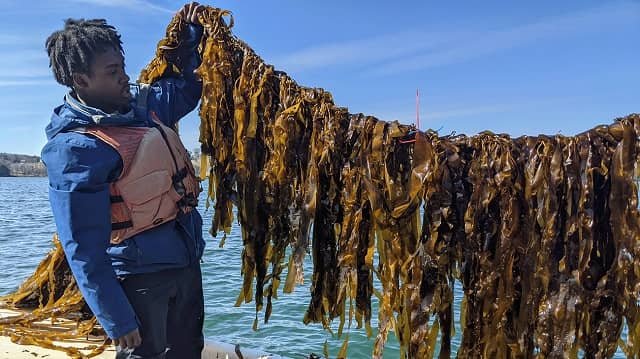by Sam Schipani, University of Maine
The University of Maine is leading an innovative new research project to collaborate with Maine’s lobster industry to explore the potential to use data owned by commercial lobstermen to map fishing effort. These data may be used to minimize conflict from potential future offshore wind development.
The state of Maine has set an aggressive goal to reduce greenhouse gas emissions and achieve carbon neutrality by 2045 and is looking to floating offshore wind development in the Gulf of Maine to supply renewable power, as well as economic benefit.
Participants in Maine’s commercial fisheries are concerned that offshore wind development could result in lost fishing grounds and pose significant navigation and safety concerns. While Maine’s lobster fishery accounted for 82% of the value of Maine’s commercial seafood landings in 2021, there are no comprehensive data on where and when Maine lobstermen fish. To minimize the impact on Maine’s lobster fishery, better data are needed on the location, type and intensity of fishing activity in the Gulf of Maine.
Kate Beard-Tisdale is leading this collaborative project to use data already being collected by commercial lobstermen to fill these data gaps.
“Right now, published maps suggest that lobster fishing is occurring everywhere. We hope through this effort to provide more spatial specificity about the most important fishing locations — where fishermen spend more time and effort,” says Beard-Tisdale, UMaine professor of spatial computing in the School of Computing and Information Science. “This spatial specificity could result in protecting fishing areas or designating areas best avoided for wind turbine placement.”
Beard-Tisdale will work closely with project partners from the Maine Lobstermen’s Association and Responsible Offshore Development Alliance and its Fisheries Knowledge Trust, as well as the University of Maine’s Lobster Institute. The project aims to develop a method to show where Maine’s lobstermen do their work throughout the year by aggregating navigation and chart plotter data from individual fishermen who have equipment that records a sequence of coordinates and documents where the boat travels. Not only would the data provide a spatially accurate picture of where fishing is taking place, but it would also be less expensive to monitor the small fishery’s activity this way than with the high cost systems used in other fisheries.
The project also will ensure that it is possible to maintain the confidential nature of individual fisherman’s data contributions. “Fishermen have a proprietary interest in where they fish and, by extension, in their plotter data, so we want to be really careful in terms of how we anonymize and combine their data such that individual fishing data are not revealed,” Beard-Tisdale says.
Ultimately, the researchers aim to build a software system that will aggregate and parse the data from various commercial systems in order for the lobster industry to be able to best inform regional energy development, fishery stock assessments, protected species management and other pressing management issues.
Stay Always Informed
Join our communities to instantly receive the most important news, reports, and analysis from the aquaculture industry.
Moreover, if the project is successful in both data collecting and anonymizing, it could build trust among fishermen, scientists and fishery managers in further developing fine scale spatial data for use in decision making.
“The Fisheries Knowledge Trust is a really valuable tool, as it provides legal and technical support for fishermen to be the holders and managers of their collective data,” says Beard-Tisdale. “The Knowledge Trust can empower fishermen by giving them control over their data. There is oversight by a board of advisors so that data products are created that the fishermen trust and that have also met the approval of the advisory board. Ideally it creates a win-win situation for improving marine spatial planning if the process gives everyone confidence in the data. If the idea takes hold it can extend to give fishermen of all types a more direct voice in marine planning activities.”
Beard-Tisdale’s research was one of six projects across the Northeast selected for funding by the Northeast Sea Grant Consortium in partnership with the U.S. Department of Energy’s Wind Energy Technologies Office and Water Power Technologies Office and NOAA’s Northeast Fisheries Science Center. The funding is meant to catalyze research for the coexistence of marine energy, including wind, current, tidal and wave energies, with Northeast fishing and coastal communities. Beard-Tisdale’s research was awarded $192,924.
“My husband worked a season on a lobster boat back in the ’70s. His boss was a strong advocate for more collective effort in managing aspects of the fishery — owning their own wharf. I see a similar situation here. Individual lobstermen have less bargaining power in these situations of competing for marine space. Collectively, by building a database that they can trust, hold and manage, they have a stronger voice for conveying their interests,” Beard-Tisdale says.
Editor at the digital magazine AquaHoy. He holds a degree in Aquaculture Biology from the National University of Santa (UNS) and a Master’s degree in Science and Innovation Management from the Polytechnic University of Valencia, with postgraduate diplomas in Business Innovation and Innovation Management. He possesses extensive experience in the aquaculture and fisheries sector, having led the Fisheries Innovation Unit of the National Program for Innovation in Fisheries and Aquaculture (PNIPA). He has served as a senior consultant in technology watch, an innovation project formulator and advisor, and a lecturer at UNS. He is a member of the Peruvian College of Biologists and was recognized by the World Aquaculture Society (WAS) in 2016 for his contribution to aquaculture.



